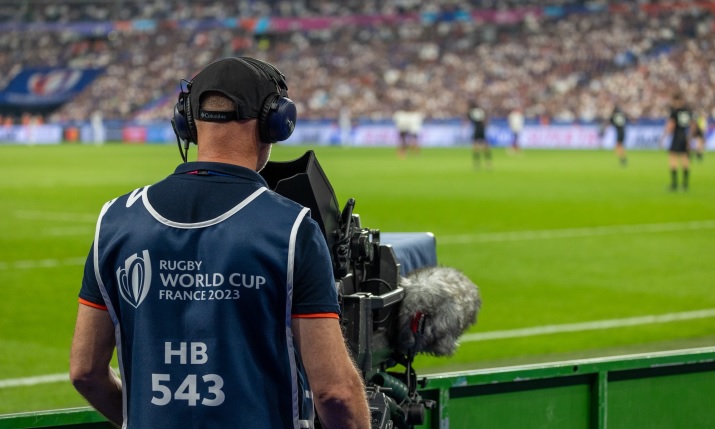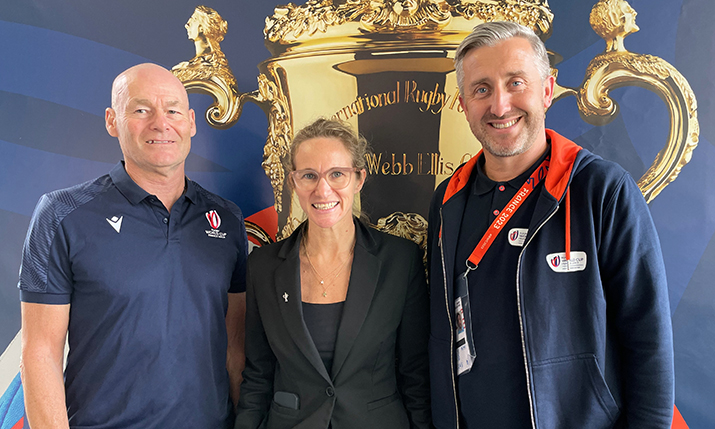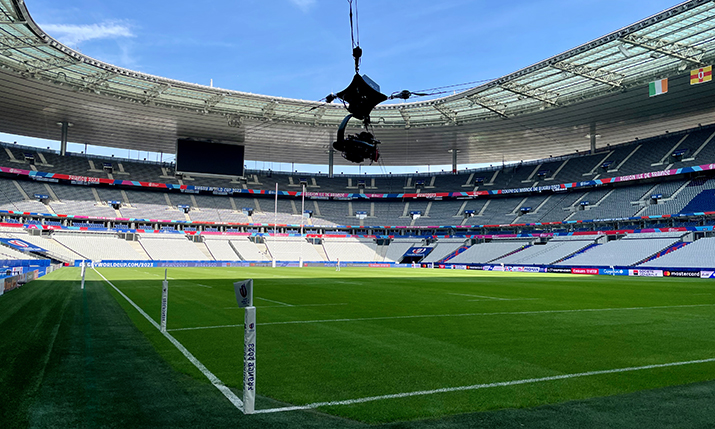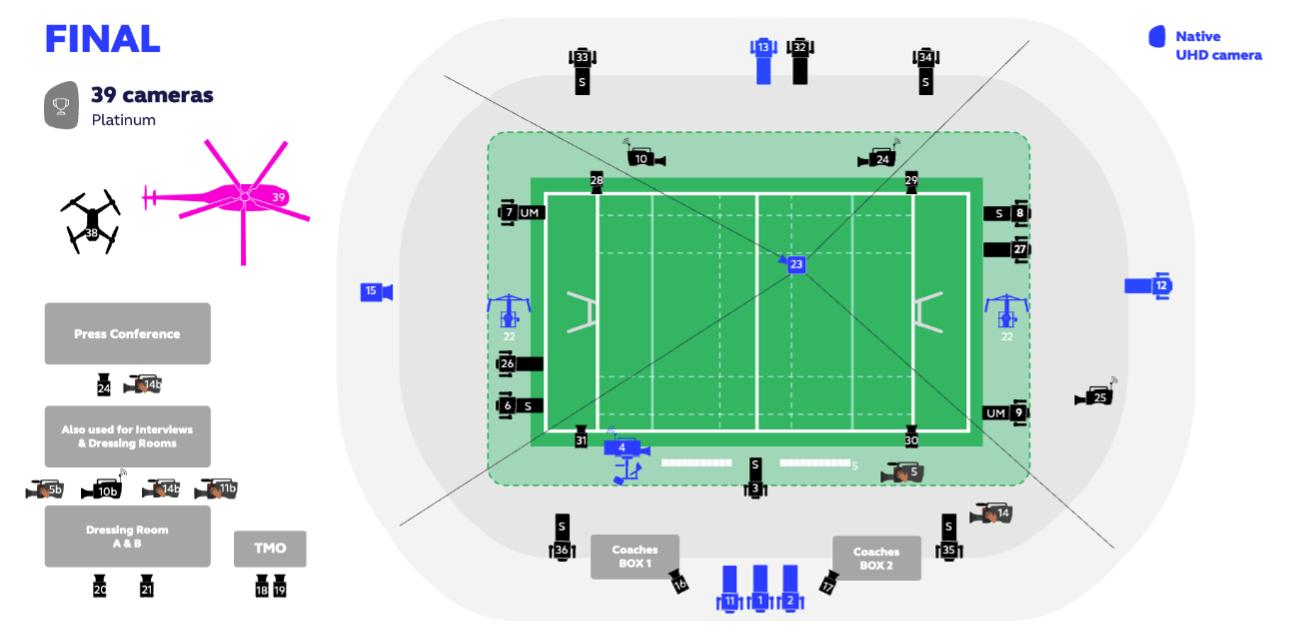Live from the Rugby World Cup 2023: Consistency and simplicity are key for host broadcast match coverage

On Saturday (28 October), Rugby World Cup 2023 will end where it began: at the iconic Stade de France, in Saint-Denis. The stadium in north Paris, which hosted the opening tie of the tournament back in early September, will provide the setting for the final between New Zealand and South Africa as the seven-week World Cup reaches its conclusion.
For World Rugby head of broadcast and production Amanda Godson, the mission for those tasked with covering the event was to produce coverage that was a significant step up on the 2019 Japan Men’s World Cup. “And we’ve absolutely done that; we’ve provided consistency across all the pool matches, while also bringing in innovations such as the cable cam for all matches. We’ve also worked closely with our rights holders to ensure they have as much knowledge of the venues and our productions and can customise their own coverage as well. We’ve created a very efficient operation and an environment in which it’s been easy for rights holders to operate in,” she says.
“As a federation, we want to attract those new viewers. So the whole philosophy around the coverage was to keep it simple so the non-rugby experts could see what was happening.”
In terms of the editorial, the approach has been to “keep it simple”, explains her colleague, World Rugby executive producer, TV and content Steve ‘Strve’ Jamieson.
“The World Cup is not just for the rugby fanatics,” he explains. “As a federation, we want to attract those new viewers. So the whole philosophy around the coverage was to keep it simple so the non-rugby experts could see what was happening.”
Coverage of the 48 matches has been split among four production teams, each of which has been led by one of four directors: French directors Laurent Daum and Samy Chatti, English director Daniel Hudson and Australian Matt Heaton. Each director has also worked with a coordinating producer to ensure consistency across the overall output. In addition, each production team also has a play-by-play commentator, colour commentator and a side-line commentator.

Left to right: Steve Jamieson, World Rugby executive producer; World Rugby head of broadcast and production Amanda Godson; HBS head of production management Gareth Jones
Host Broadcast Services (HBS) executive producer for RWC 2023, Julian Bertin, expands on Jamieson’s point: “Rugby can be very complex, so the remit was to make the game as understandable and simple as possible,” he says.
Having worked on the coverage of the Rugby World Cup 2019 in Japan, HBS was once again tasked with providing host broadcaster coverage of the tournament, ensuring live feeds of all 48 matches along with a host of additional programming and digital content has been available to rights holders.
Continues Bertin: “With World Rugby, we worked really hard on production guidelines for our directors. We did workshops and brainstorming with those four teams about how to cut the game to make it as entertaining and enjoyable, while also being understandable too. We said, ‘don’t address the experts, address newcomers and make it make it simple for them’.”
“The cable cam is the best camera you have in rugby. We’ll always follow a penalty with it, but the main reason is that we want tactics to be clear to viewers.”
One of the ways in which they have tried to make the game easier to understand is giving more air time to the referees.
“In the briefing we give to the commentary team we said whenever there’s a decision from the referee, be quiet and let them speak because they will explain it best. And then you can bounce off that statement or decision if you agree or disagree.”
While the directors are rugby specialists highly experienced in covering the sport, a quality control team led by a director who is not considered such a rugby expert supports and questions the coverage.

Explanations and atmosphere
A new addition to this tournament is a cable camera (pictured above) at every match, the purpose of which is to provide further clarity to viewers. “It’s the best camera you have in rugby,” says Bertin. “We’ll always follow a penalty with it, but the main reason is that again, we want tactics to be clear to viewers.” In addition, each fixture also has a drone to provide views of the stadium and surrounding area.
Adds Jamieson: “It all comes down to not just watching it on TV, but for the fans to feel like they are at the stadium. I often tell the commentary teams that their biggest asset sometimes is not talking; if a try’s been scored, stop talking because every viewer at home whose team just scored is going to be yelling at the TV. And those fans whose team has conceded will be yelling at the TV too. It’s a bit of a new style of commentary where we really push for those gaps.”
To add to the atmosphere, heading into the tournament one of the messages from rights holders was that they wanted to be closer to the action. “Generally speaking, [rights holders] don’t want to be sitting inside a studio, they want to get the atmosphere through their production. So we have the pitch-side presentation positions, but we have also knocked down the studio walls to create the announce platforms, and they’ve been very popular,” says Godson.
Camera coverage

As the tournament has progressed, the number of cameras used to capture the action has increased, from 25 cameras per match for the group stages, increased to 33 during the quarters, 38 for the semi-finals and then up to 39 cameras for the final on Saturday (illustrated above).
New cameras this year include cine-style cameras, introduced in a bid to capture more emotional reactions of players and fans. And, from the quarter-finals onwards, a second cine-style camera has been added for equal coverage of both ends of the stadium, along with cameras in the corner flags (“and if a player wipes one out, fantastic!” says Jamieson).
Also, a couple more ultra motion cameras, and from the semi-finals on, a second reverse camera to allow for one dedicated to match coverage, plus one trained on the coaches. Plus, for the final, helicopter coverage and motorbikes following the team buses to add to the extra pre-match coverage.
All of this coverage is packaged into a range of seven feeds, including a basic stadium feed produced at each venue, plus an additional content feed with a lot of pre-match content with footage of fans, player warm-ups and arrivals and some unseen angles, as well as the world feed – the same as the basic stadium feed, but with pre and post-match unilateral opportunities for broadcasters to do standups and flash interviews.
And, rights holders are provided with a few ISO camera feeds as well; the all-important cable cam, camera 1, a tactical beauty shot and cine-style.
The 2023 Rugby World Cup continues in France until Saturday 28 October.
Read more:
- Live from the Rugby World Cup 2023: World Rugby and HBS offer up additional content for rights-holding broadcasters
- Live from the Rugby World Cup 2023: Referee mic plays crucial role in capturing atmosphere and ambience
- Live from the Rugby World Cup 2023: “Immersive and emotional” cinema-style shots bring fans closer to the action

